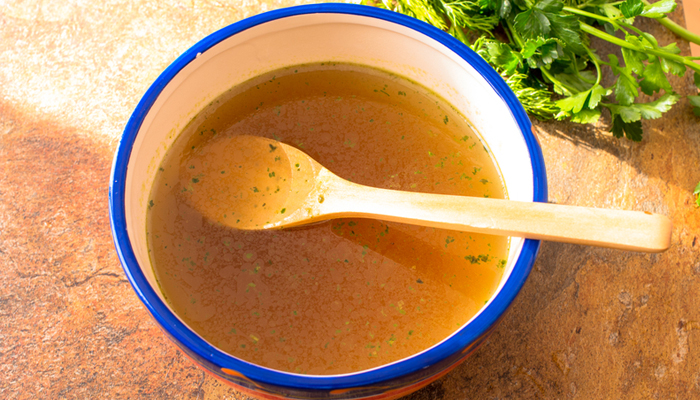
Portable Soup was the 18th century’s’ version of dehydrated food. Many considered it emergency rations while others used it almost on a daily basis as a base for recipes or as a meal. Lewis of the Lewis & Clark Expedition became aware of the soup while ordering supplies for the expedition, and ordered 150 pounds, but 193 pounds was actually shipped at a cost of $289.50, a considerable sum of money for soup in 1804. The soup arrived in 32 tin canisters (FoodTimeline Library , n.d.).
What Is Portable Soup
Today we call it Bouillon or homemade stock, and it is made from roasting and then boiling meaty bones. The stock is reduced several times until it takes on a gelatin-like consistency. Once somewhat solidified it is cut into cubes and dried in a cool place with low humidity. Centuries ago, Portable Soup was made in the wintertime, so it could dry out sufficiently enough to keep for months on the shelf without going rancid.
Most food historians credit Mrs. Dubois, a London tavern keeper for inventing the product. She along with William Cookworthy won a contract to manufacture it for the Royal Navy in 1756. There were several versions of the same recipe described in the 16th century, however, but Mrs. Dubois is considered the first one to commercially produce and sell the product.
Here is an original quote by Sir Hugh Plat in the early 16th century with the common spelling of the day left intact. He was describing the recipe and methods and was writing to inform others of the potential use of the soup by the army and navy.
“Boil the feet or legs of beef cattle for a long time to make “a good broath” which was then strained and boiled down to “a strong & stiff gelly”. This, in turn, was dried on clean cloths in a windy place out of the sun, cut with wire into pieces, powdered with flour to stop the pieces sticking, and stored in wooden boxes. Made in March, it would “keepe all the yeere”
The original recipe called for veal knuckle bones, which as a rule produce a good color and, strong gel. However, any bones or a combination of bones can be used to create Portable Soup.
Making Portable Soup
- Meaty Bones Such as Chicken, Lamb, Beef or Pork or Use Game Animals.
Most recipes will call for a Certain Number of Pounds and How Many Depends on How Much You Want to Make and The Size of Your Roasting Pan and Stock Pot. Ten Pounds is A Good Starting Point However.
- 2 Tablespoons Black Peppercorns
- 2 Bay Leaves
- 2 Teaspoons Salt (Sea Salt Is Ideal)
- 2 Tablespoons Gelatin (Optional) The Gelatin Is Added To Help With Gelling
Roast just the bones at 400° F for one hour in a preheated oven or in a Dutch oven with hot coals on top and underneath.
Once the roasting is done, place the bones, bay leaves, and peppercorns in a large pot and cover with water. Do not add the salt or the gelatin at this point. Bring the water to a boil and then reduce the heat to a simmer. Simmer for 10 to 12 hours.
After simmering for 10 to 12 hours, strain the stock using a fine mesh. You can line a colander with cheesecloth for straining. Refrigerate for 24 hours. The fat will rise to the top and harden. Remove the hardened fat and save for later use.
Now you will reduce the stock even more by adding the salt and bringing it to a boil and then reduce to a simmer for one hour. Once done, whisk in the gelatin if you want. Pour into a 4×4 pan. It will take roughly eight hours in the refrigerator for the soup to gel up enough to cut into cubes. Typically, the cubes are 1×1 inch.
Once cut, place the cubes on pieces of cloth to dry out, and you can put them in the refrigerator or in a cool and dry spot somewhere else for 24 hours, and once dried the cubes can be stored in an airtight container on the shelf for up to six months.
A 1-inch-by-1-inch cube yields about one cup of broth. Just put the cube in hot water and drink as is, or add to any recipe that calls for stock or to any food you want to add flavor too.
The broth is high in protein and can be used as an emergency meal, and it goes well with hardtack. Dip your hardtack in the broth to soften and then bite off a piece or soak the entire biscuit in the broth and eat that way.
FoodTimeline Library . (n.d.). Retrieved 2016, from http://www.foodtimeline.org/foodpioneer.html